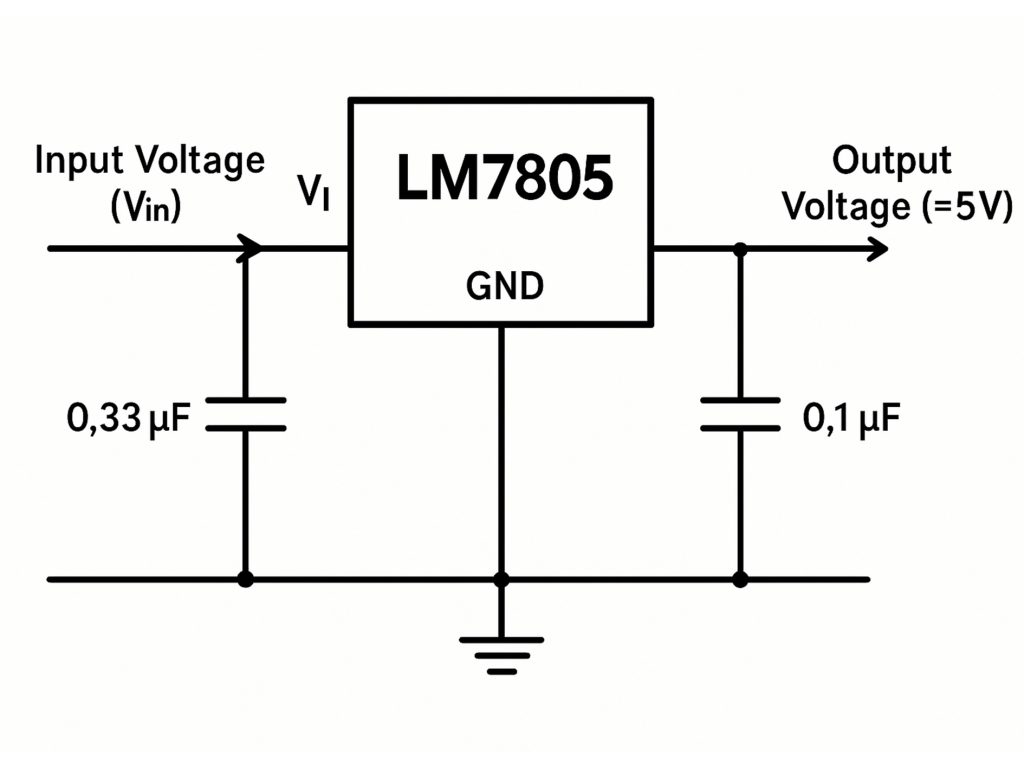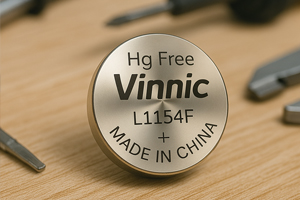LM7805 Voltage Regulator Pinout, Works and Equivalent
Author:admin Date: 2025-04-14 07:31 Views:175
LM7805 5v Voltage Regulator – How It Works
In the world of electronics, maintaining a stable power supply is essential to ensure the reliability and longevity of electronic circuits. This is where voltage regulators like the LM7805 voltage regulator become crucial. Whether you’re building a basic LED driver or a microcontroller-based application, the LM7805 is one of the most reliable and widely used components for delivering a consistent 5V output.
In this comprehensive guide, we’ll cover the LM7805 pinout, how it works, specifications, use in Arduino power supply circuits, and much more. Discover why this component is considered the best 5V linear voltage regulator for beginners and professionals alike.
What is the LM7805 Voltage Regulator?
The LM7805 is a 5V linear voltage regulator from the 78xx series. It converts a higher unregulated input voltage into a fixed +5V output. As a positive voltage regulator, it ensures stable operation of your power supply rail. The “05” indicates a 5-volt output.
This component is widely used in electronics projects, Arduino circuits, and embedded systems due to its simplicity and reliability.
LM7805 Features
The LM7805 is known for its ease of use, affordability, and built-in protection features.
Output Voltage: Fixed +5V ±2%
Input Voltage Range: 7V to 35V (recommended: 9V–12V)
Maximum Output Current: 1.5A (with proper heatsinking)
Dropout Voltage: ~2V
Internal Protections:
1. Thermal shutdown
2. Short-circuit protection
3. Overcurrent protection
To improve stability, place a 0.33µF capacitor at the input and a 0.1µF capacitor at the output, close to the regulator pins.
LM7805 Pinout (TO-220 Package)
Understanding the LM7805 pinout is essential before integrating it into a circuit. The most common package type is the TO-220, though it is also available in TO-92 (for lower current applications) and surface-mount SOT-223 packages.

Below is the pin configuration for the TO-220 package:
| Pin Number | Name | Description |
|---|---|---|
| 1 | Input | Voltage input (7V to 35V) |
| 2 | GND | Ground (0V reference) |
| 3 | Output | Regulated +5V output |
To ensure stability, it is recommended to connect a 0.33µF capacitor at the input and a 0.1µF capacitor at the output, placing them as close as possible to the LM7805 pins.
How Does the LM7805 Voltage Regulator Work?
To effectively use the LM7805 voltage regulator, it’s important to understand how it operates. As a linear regulator, the LM7805 works by reducing the excess input voltage through heat dissipation, while maintaining a steady output of +5V.
Its internal circuitry is designed to handle variations in both the input voltage and load conditions, ensuring a stable output. This makes the LM7805 ideal for powering sensitive electronics such as microcontrollers, sensors, and communication modules.
Working Principle
The core operation of the LM7805 involves a series pass transistor, a voltage reference, and an error amplifier. Here’s how the process unfolds:
Voltage Reference:
The LM7805 contains an internal 5V reference, which serves as the target voltage for the output.
Error Amplifier:
The error amplifier compares the output voltage to this reference. If the output is too low, the amplifier increases the conduction of the pass transistor, raising the voltage. If the output exceeds the desired value, conduction is reduced.
Series Pass Transistor:
Acting like a variable resistor, the pass transistor controls the flow of current from the input to the output, adjusting in real-time to maintain a constant 5V output.
Feedback Loop:
This closed-loop system continuously adjusts itself to maintain a stable output, even if the input voltage or load conditions change.
Heat Dissipation:
The difference between the input and output voltage is dissipated as heat. For instance, converting 12V to 5V at a 1A load results in:
Power Dissipated = (Vin−Vout) × Iload = (12V – 5V) × 1A = 7W
This design ensures the LM7805 is ideal for low-noise, low-ripple, regulated 5V supplies, especially in analog and digital circuits that cannot tolerate power instability.
LM7805 Circuit Example

Here’s a simple and commonly used LM7805 voltage regulator circuit, perfect for providing a stable 5V DC output to digital components such as microcontrollers, sensors, or logic ICs.
Circuit Description:
This example demonstrates how to connect the LM7805 properly to deliver a clean +5V output:
Input Voltage (Vin):
The circuit requires an unregulated DC voltage, typically between 7V and 25V. The LM7805 needs at least 2V more than its output (i.e., the dropout voltage), so a 9V or 12V supply is ideal.
Input Capacitor (0.33µF):
This capacitor filters high-frequency noise from the input voltage and should be placed as close as possible to the input pin of the LM7805 for maximum effectiveness.
LM7805 Regulator:
The LM7805 itself regulates the voltage and ensures a stable 5V output.
Ground (GND):
Connect all grounds (input capacitor, output capacitor, and LM7805 pin 2) to a common reference.
Output Capacitor (0.1µF):
This capacitor helps maintain output stability, especially under varying loads, and minimizes voltage spikes and high-frequency noise.
Output Voltage:
The right side of the circuit will deliver a clean +5V output, which is ideal for powering 5V logic circuits, sensors, or even an Arduino board.
Key Notes:
1. Always keep the capacitors close to the LM7805 pins to prevent unwanted noise or instability.
2. This circuit can handle up to 1A (or more with proper heatsinking), making it suitable for medium-current applications.
3. For additional protection, consider adding a reverse polarity diode and a larger bulk capacitor if the input voltage is unstable.
Applications of LM7805
The LM7805 voltage regulator is widely used in electronics to provide a stable 5V output. Some common applications include:
Microcontroller Power Supply:
Powers 5V microcontrollers such as Arduino, ATmega, and STM32.
Arduino Projects:
Regulates 9V/12V inputs to 5V for reliable operation of custom Arduino setups.
Sensor Modules:
Provides 5V power for sensors like IR, ultrasonic, and LM35.
Robotics & Embedded Systems
Supplies logic voltage for motor drivers, Bluetooth/WiFi modules, and control circuits.
Battery-Powered Devices:
Converts battery voltages (e.g., 7.4V, 9V) to 5V for safe operation.
DIY Power Supplies:
Used in simple 5V bench power supplies for circuit testing.
Consumer Electronics:
Found in devices like radios and DVD players to power 5V logic sections.
LM7805 Arduino

Can LM7805 Power Arduino?
Yes, the LM7805 is an excellent option for powering many Arduino boards (e.g., Uno, Nano, Mega), which operate at 5V.
How to Connect:
Input: Provide a 9V–12V battery or adapter to LM7805.
Output: Connect the 5V pin of LM7805 to the Arduino 5V pin.
GND: Ensure a common ground between the LM7805 and Arduino.
Tips for Using LM7805 with Arduino:
1. Always add capacitors near input and output to prevent voltage spikes and noise.
2. Consider using a heatsink if your circuit draws more than 300–500mA.
3. Avoid conflicts with USB by never connecting the Arduino USB while it’s powered via the LM7805 5V pin.
4. Test the output with a multimeter before connecting to the Arduino.
Common Arduino Projects Using LM7805:
1. Portable Arduino projects with 9V batteries
2. Solar-powered Arduino weather stations
3. Motor controller circuits with separate power supply
4. Sensor nodes and IoT devices with regulated 5V supply
5. Robotics kits using external power for servos and logic boards
LM7805 Equivalent and Replacements
If the LM7805 is unavailable or unsuitable, you can use the following alternatives:
Linear Equivalents:
| Picture | Model | Output Voltage | Efficiency | Pin Compatible | Package | Notable Differences |
|---|---|---|---|---|---|---|
 |
LM7805 | 5V | 40–60% | Yes | TO-220 | Standard linear regulator, widely used |
 |
KA7805 | 5V | 40–60% | Yes | TO-220 | Functionally identical, different manufacturer |
 |
MC7805 | 5V | 40–60% | Yes | TO-220 | Same specs as LM7805, ON Semiconductor brand |
 |
L78S05CV | 5V | 40–60% | Yes | TO-220 | Higher current capability (up to 2A) |
 |
UA7805 | 5V | 40–60% | Yes | TO-220 | Earlier version, legacy design |
Switching Replacements (Higher Efficiency):
| Picture | Model | Output Voltage | Efficiency | Package | Notable Differences |
|---|---|---|---|---|---|
 |
LM2596-5.0 | 5V (Fixed) | 70–85% | TO-220 / Module | High efficiency, requires external components |
 |
MP1584EN | Adjustable | 75–90% | SOT-23-5 | Ultra-compact SMD switching regulator |
 |
XL4015 | Adjustable | 75–90% | Module | Supports higher current (up to 5A), module form |
 |
R-78E5.0 | 5V (Fixed) | 85–96% | SIP-3 | Drop-in switching replacement for LM7805 |
 |
TSR 1-2450 | 5V (Fixed) | 85–94% | SIP-3 | Compact SIP module, high efficiency, no heatsink needed |
Switching regulators offer better efficiency but may introduce ripple, making them ideal for power-sensitive applications like battery-powered devices.
LM7805 Package (TO-220 Package)

The LM7805 is commonly available in the TO-220 package, which is well-suited for power components due to its robust design and effective heat dissipation.
Heat Dissipation:
The metal tab on Pin 2 acts as a heatsink, allowing the LM7805 to dissipate excess heat, essential for higher currents (up to 1A).
Thermal Performance:
Efficient thermal management, ensuring safe operation under load.
Dimensions
The TO-220 package typically has the following dimensions:
Length: 10.2mm
Width: 4.5mm
Height: 15.4mm (with the metal tab for heatsinking)
This makes the TO-220 package versatile, suitable for both through-hole and some surface-mount designs with specific adapters.
Conclusion
While the LM7805 has limitations in heat dissipation and efficiency, it remains an ideal choice for low-cost, small-scale, or beginner projects. For high-efficiency applications, switching regulators can be considered, but for simplicity, reliability, and ease of use, the LM7805 remains hard to beat.
Whether you’re working on Arduino projects, powering sensors, or integrating LEDs, the LM7805 provides a stable, practical solution to ensure your components get the 5V they need.
Please send RFQ , we will respond immediately.
Frequently Asked Questions
1. What is the price of LM7805?
The LM7805 typically costs between $0.10 and $1.00 USD, depending on the brand, quantity, and supplier.
2. What does the LM7805 datasheet include?
The datasheet provides electrical specifications, thermal ratings, pinout diagrams, application circuits, and recommended operating conditions.
3. Where can I download the official LM7805 datasheet?
You can download the official datasheet of LM7805 from our official website
4. Can I connect two LM7805 regulators in parallel for more current?
No, it’s not recommended because they won’t share current evenly. Use a higher current regulator or a proper load-sharing design instead.


